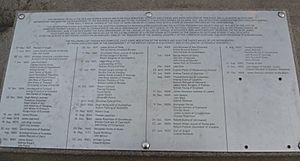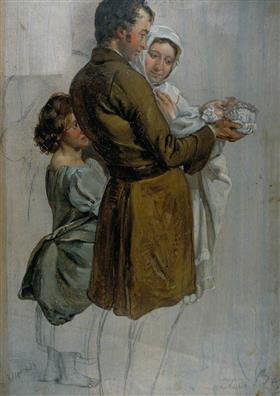John Nisbet facts for kids
Quick facts for kids
John Nisbet of Hardhill
|
|
|---|---|

conventicle near Loudoun Hill
|
|
| Born | 1627 |
| Died | 4 December 1685 (executed) Grassmarket, Edinburgh |
| Buried | |
| Allegiance | |
| Rank | Captain |
| Battles/wars | Battle of Rullion Green Battle of Drumclog Battle of Bothwell Bridge |

John Nisbet (1627–1685) was a Scottish covenanter. He was a brave leader who fought for religious freedom and civil rights in Scotland. He took part in several important battles and meetings of the Covenanters.
Nisbet was badly hurt at the Battle of Rullion Green in 1666, but he survived. He later fought as a captain at the Battle of Bothwell Bridge in 1679. Because of his actions, he was later captured and executed. John Nisbet was also a descendant of Murdoch Nisbet, who translated the Bible into the Scots language.
Contents
Early Life and Beliefs
John Nisbet was born in 1627. His father, James Nisbet, was a farmer in Drakemyre, Ayrshire. His mother was Jane Gibson.
As a young man, John Nisbet traveled to Europe. There, he became a professional soldier and fought in the Thirty Years' War. This experience likely made him a skilled fighter.
In 1650, he returned to Scotland for the coronation of King Charles II. At this event, he signed the Covenants. This was a promise to support the religious and political changes that had happened in Scotland between 1638 and 1649.
After this, he went back to his family home at Hardhill, near Loudoun. In 1651, he married Margaret Law.
Standing Up for His Faith
John Nisbet was a strong believer in the Covenanter cause. This meant he supported the right for Scottish people to worship freely, without the king or bishops telling them what to do.
In 1664, he upset the local church leader. This happened because he had his child baptized by a minister who had been removed from his church. The church leader planned to punish Nisbet, but he died suddenly.
After the king was restored to power, Nisbet continued to fight for religious and civil freedom. He refused to follow the new church rules. Instead, he attended secret church meetings held by ministers who had been forced out of their churches. These meetings were called "conventicles."
Key Battles and Capture
John Nisbet was a key figure in the Covenanter struggles.
- In 1666, he renewed his promise to the Covenants at Lanark.
- He was part of a small group who made important declarations in Rutherglen, Glasgow, and Sanquhar.
He fought bravely at the Battle of Rullion Green on November 28, 1666. He was severely wounded and left for dead on the battlefield. But he managed to escape and recover.
Nisbet then fought as a captain in two more major battles:
- The Battle of Drumclog on June 1, 1679.
- The Battle of Bothwell Brig on June 22, 1679.
Because of his leadership in these battles, he was declared a rebel. A reward of three thousand merks (about £165 sterling) was offered for his capture.
In April 1685, Nisbet and another Covenanter, Alexander Peden, narrowly escaped capture at Nisbet's house. However, in November 1685, he was finally caught. This happened at a place called Midland in Fenwick, Ayrshire. His captor was his own cousin, Lieutenant Robert Nisbet. His three companions were shot immediately, but John Nisbet was spared for the reward.
Execution and Legacy
After his capture, John Nisbet was taken to Edinburgh. He was put on trial and sentenced to death.
On December 4, 1685, John Nisbet was executed by hanging in the Grassmarket in Edinburgh. This area was a common place for public executions.
John Nisbet was buried at Greyfriars Kirkyard in Edinburgh. There is also a memorial monument dedicated to him at Loudoun Parish Kirk in Newmilns. This memorial honors his bravery and his fight for what he believed was right.
Family Life
John Nisbet married Margaret Law in 1651. They had several children, but only three sons survived him: Hugh, James, and Alexander.
His son, Serjeant James Nisbet, later wrote a diary. This diary shared many religious thoughts and included a description of Alexander Peden, another important Covenanter.
See also
- Murdoch Nisbet
- John Nisbet, the younger



